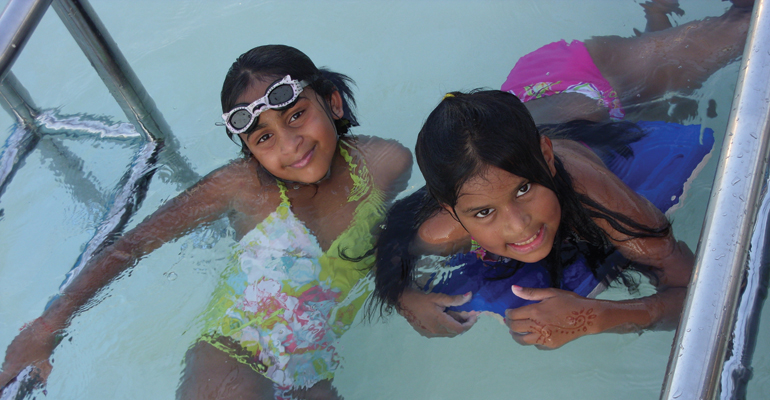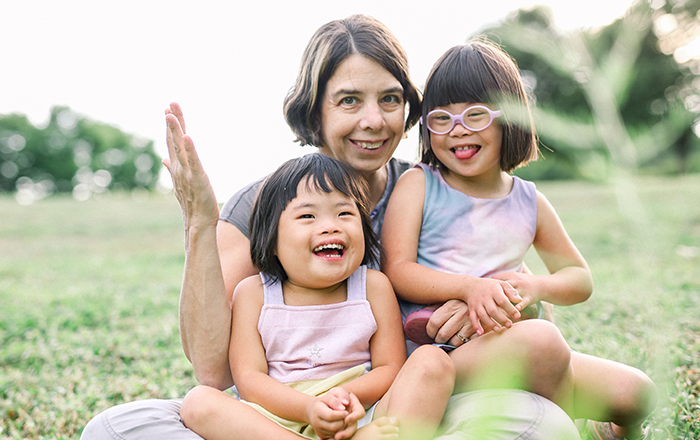In the blue of the pool, between waves and the tiled bottom, I lost her. My 10-year-old daughter was somewhere in the chaos of arms, legs, and heads bobbing and churning in the chlorine. Finally, I spotted her, her hair thick points of streaming water as she climbed the ladder out of the deep end and walked toward the diving board.
“Tess, I’ve been looking for you, honey,” I said. But as I touched her cool, wet arm, the face that met mine wasn’t my daughter’s.
“Sorry,” I said, returning my gaze to the pool.
“Mom, I’m over here,” called Tess from the shallow end. She was laughing. “You did it again, didn’t you?” she asked, and I nodded, embarrassed, because I do this once a year, every year. Lose my daughter. And the thought of it makes us both laugh.
We live in a Big Ten university town. There is diversity here, but when we are out as a family, at a park or a pool, I can usually find Tess. She’s the one with hair the color of coffee, skin a softened caramel, the girl who runs with a lightness I can’t match. She’s easy to spot in a current of blond and brown hair.
But every summer, at Dillon International’s India Camp, she’s “every girl” and my husband and I are the “different.” And she loves it. “I like my brown better,” she says, and I’m glad she feels that way. When Tess was little, we thought we wanted to be color-blind. After all, we didn’t think about our differences, we just noticed our similarities, our unmitigated love for each other. But we don’t look alike, and the rest of the world sees that and stares. Now our differences are something we celebrate.
On our two-day car ride to camp last summer, Tess said, “I can’t wait to be with my people.” When I asked what she meant, she laughed. “You know. Adopted Indian kids. Not just Indians, like our friends.”
Her People
“I’m the only kid in my whole school who’s from India,” Tess announced after her first week in kindergarten. We had enrolled her in our neighborhood elementary, where there was diversity, but not Indian diversity, and she noticed. So when we moved her to an elementary that resembled the U.N., in the third grade, she loved it. She came home daily with updates of classmates — Afghanistan through Zimbabwe — who were her new friends. But then their adoption questions began. Kids who were unfamiliar with it, whose cultures kept adoption hush-hush, were intrigued and, sometimes, rude.
One night, after our bedtime ritual of Tell Me Three Dreams, Tess began to cry. She had been asked every day, “Where’s your real mom? How come your real mom gave you away? Are you happy living with those people, instead of in India with your real mom?” and was frustrated. “I’m tired of kids asking me about adoption every day,” said Tess. “So-and-so follows me around and says she feels sorry for me.” I asked Tess what she wanted me to do. “Will you come and talk to the class, like you did at my other school?” she asked. And I realized my mistake. Because her school was so diverse, I had made the assumption that all kids, regardless of family make-up, color, or background, would be accepted there. I had equated diversity with understanding.
I gave an adoption presentation to Tess’s class the next week. And at home we practiced W.I.S.E. Up, a technique we had learned at India Camp that suddenly had a real-world application. (When they’re asked an intrusive question about adoption, children can either Walk away; say “It’s private”; Share something; or Educate.) I discovered that, for Tess, “walk away” was the most difficult aspect. Giving my daughter permission to choose not to answer an intrusive question was powerful. It worked. School once again became what she wanted and needed.
Her Authentic Self
My husband and I have used our India Camp experiences throughout the year, every year since we’ve attended. The panel discussions and the conversations with other parents have influenced what we do and how we do it. When our girls were little, we talked about adoption in general terms — how to handle racism, how to answer birth parent questions. As parents of preteens, we now wonder, will Indian boys consider dating our daughter, who is Indian, but who doesn’t speak Hindi? Who knows how to make dal and loves palak paneer, but lives with parents with ancestral ties to the Emerald Isle? How can we give our daughter a little experience of India while living outside of it?
For now, the answer is India Camp. Every summer, volunteers from the India Association of Greater Tulsa teach our kids history, language, and culture. They feed them and dress them in traditional attire. Tess looks forward to seeing the teen girls who volunteer from the IAGT as much as her camper friends. Last year, two teens taught the campers a Bollywood-style musical number that had them enthralled.
We feel fortunate to have the support of other parents who are trying to figure it out, but Tess has been the real winner. Our daughter is a rule-follower. Obedient. Cautious. She’s the girl who raises the hand no one sees. But India Camp is changing that — turning some of the hesitancy into determination. It has given her a love for the stage. The 10-minute skits she participates in each year put her in front of an audience, as her authentic self — artsy and happy. They’ve given her the confidence to play a leading role in two school plays, and the grace to admit defeat when she tried out for a solo. “I’m so happy for Karen, Mom. She sang way better than I did.” Yes, an opportunity to know who she really is, inside out and outside in.
Our Community
Earlier that day, the day I lost her last summer, Tess stood poised to jump from the high dive. Suddenly, she froze. The lifeguards told her she had to jump, couldn’t back herself down the ladder to the safety of my arms. As a lifeguard swam into the glinting water below the board, parents and kids shouted encouragement from around the pool. “You can do it!” “It’s OK, you’ll be safe.” Tess’s eyes locked on mine and it seemed like forever and ever passed before, crying, she stepped off the edge. As she bobbed to the surface, everyone cheered and clapped. Campers ran to her as she climbed from the pool and into my hug. They offered congratulations and their own stories of being scared. I fought back tears because this little community of families was so supportive, so kind. And I knew that we would catch each other’s children, help them figure out how to negotiate not just the pool, but life.



